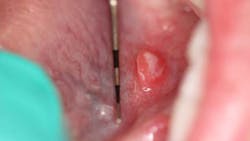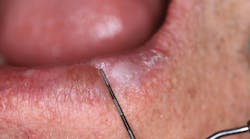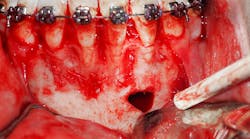Pathology case: Differentiating a common lesion
Editor's note: Originally published February 2017. Updated August 2024.
A healthy 8-year-old female presents to the office for a routine recare exam. Neither she nor her mom had any concerns.
While performing the head, neck, and oral cancer screening exam, a raised, round soft-tissue lesion approximately 6 mm x 6 mm was observed under the left side of the tongue along the sublingual salivary gland ducts. The outside border was red and contained a white center. The lesion and area in general were not tender to palpation, and both mom and patient were unaware of its presence.
There was no recollection of trauma to the area.
Differentials
- Aphthous ulcer (minor) aka canker sore
- Blockage of salivary duct (mucocele)
- Idiopathic irritation/traumatic ulcer
- Recurrent intraoral herpes simplex (RIHS)
Definitive diagnosis: Aphthous ulcer (minor)
Apthus ulcers (minor) are “small superficial ulcers of the oral gland-bearing mucosa that occur episodically in clusters of one to five lesions.”1 It is the most common type of aphthous ulcer found.2 The lesions occur throughout the mouth, including the soft palate, floor of mouth, tongue, mucobuccal fold, buccal mucosa, lips, and movable mucosa (nonkeratinized).2
Etiology and treatment
Aphthous ulcers have a slight prevalence in women2 and treatment is palliative, as the lesions are self-limiting and will resolve in typically seven to 10 days. Application of rinses or topical ointments can be applied; numbing agents such as benzocaine are also helpful.
Of interest, the recurrence (and appearance) of aphthous ulcers is similar to recurrent intraoral herpes simplex. One of the main differentiating features is that RIHS is typically found on keratinized tissue, and the lesions often return to the same location. It is, therefore, prudent to be aware of patterns and frequency of any lesions that have a common occurrence.
In this particular case, the patient was seen 10 days later, and the lesion had self-resolved. A discussion with mom revealed that the patient did indeed have a tendency to get aphthous ulcers. This lesion was apparently small and isolated enough (as a single lesion) that the discomfort factor was not an issue. No further follow-up was necessary.
References
- Sapp JP, Eversole LR, Wysocki GP. Contemporary Oral and Maxillofacial Pathology. Mosby; 1997:246-247.
- Wood NK, Goaz PW. Differential Diagnosis of Oral and Maxillofacial Lesions. 5th ed. Mosby; 1997:165-167.
About the Author
Stacey L. Gividen, DDS
Stacey L. Gividen, DDS, a graduate of Marquette University School of Dentistry, is in private practice in Montana. She is a guest lecturer at the University of Montana in the Anatomy and Physiology Department. Dr. Gividen has contributed to DentistryIQ, Perio-Implant Advisory, and Dental Economics. You may contact her at [email protected].




